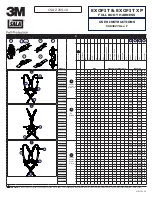
190 | Chapter 4: Maintenance
l
Peri-pump Dispenser Maintenance on page 192
l
Syringe Dispenser and Strip Washer Maintenance on page 201
Autoclavable Components
Autoclaving is an efficient method of sterilizing instrument components. For
qualified items, it is a good alternative to some of the decontamination procedures.
Do autoclave:
Do NOT autoclave:
Peri-pump cassettes
Washer manifolds
16-Tube and Low-density-plate-type-
specific Syringe dispenser manifolds
Plate carrier
Priming trough inserts
32-Tube Syringe dispenser manifolds
Autoclavable Syringe pump head
(glass/stainless steel)
8-Tube Syringe dispenser manifolds (gray
block holds two manifolds, 16 tubes total)
Syringe module tubing with transparent
amber check valves and glass bottles
Non-autoclavable syringe pumps (black plastic)
Non-autoclavable syringe accessories: white
check valves and plastic bottles
l
Autoclaving the cassette typically increases the tubes' capacity. Expect the cassette to
dispense more fluid than expected immediately after sterilizing or disinfecting the
tubing. (When the cassette is completely dry, dispense volumes return to normal.)
l
Autoclaving the dispense cassette does not diminish its expected life.
Clean the Bottles
l
Clean and rinse the supply bottles with deionized water before the first use, before each
refill, and, periodically, as necessary, to prevent bacteria growth.
l
Empty the waste bottle often (at least daily), and firmly seat the waste bottle stopper.
l
Rinse the covers every time the wash or rinse bottles are filled.
l
Accumulated algae, fungi, or mold may require decontamination.
n
To ensure that fluid does not back up into the vacuum pump during operation,
always operate the instrument with the
waste sensor cable
installed and the
waste detection sensor
enabled (the sensor is enabled by default).
If fluid collects in the
overflow bottle
, thoroughly rinse the level-switch
assembly and bottle.
MultiFlo™ FX Multi-Mode Dispenser
















































